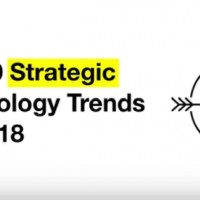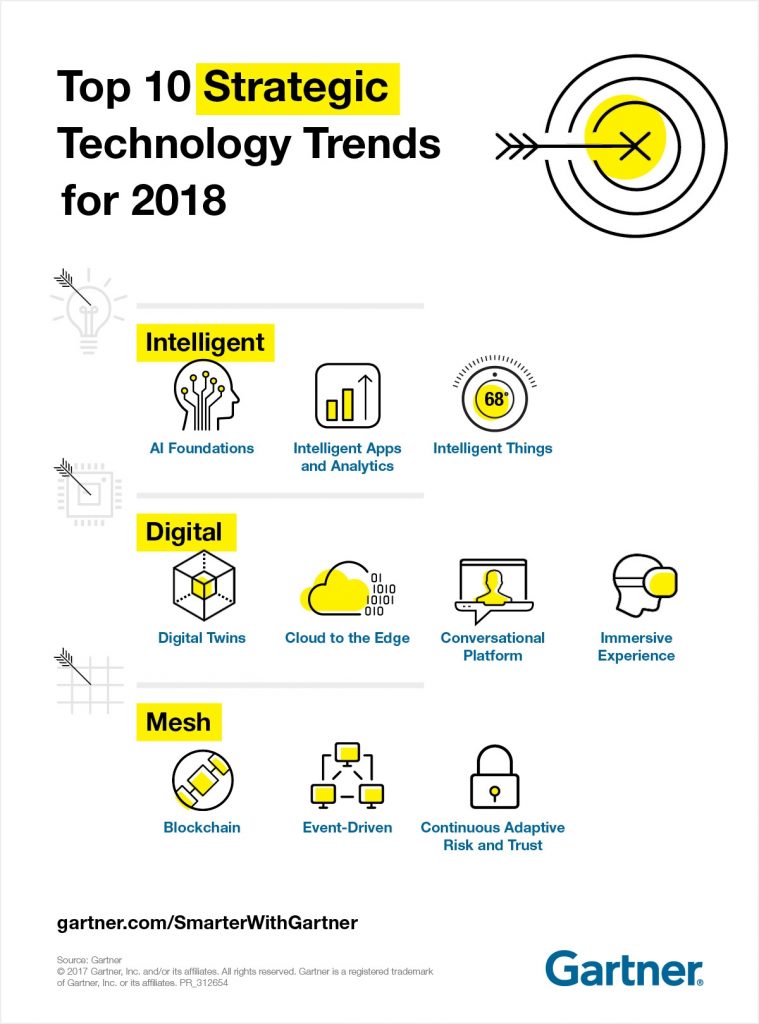Das Beratungs- und Researchunternehmen Gartner benennt die zehn wichtigsten strategischen Technologie-Trends für 2018. Primär sind es intelligente Anwendungen und Technologien, die zukünftig in die Unternehmensstrategie einfließen werden.
Als strategischen Technologie-Trend definiert das IT-Research und Beratungsunternehmen Gartner entweder einen Trend mit substanziellem Disruptions-Potential, der gerade das Anfangsstadium verlässt um in ein Stadium breiterer Nutzung und entsprechenden Einflusses einzutreten – oder einen Trend, der sehr schnell wächst, ein hohes Maß an Volatilität zeigt und in den nächsten fünf Jahren einen Wendepunkt erreichen wird.
„Gartners Top 10 strategische Technologie-Trends stehen in Zusammenhang mit dem Intelligent Digital Mesh, einer Grundlage des Digitalgeschäfts und der digitalen Ökosysteme der Zukunft“, erklärt David Cearley, Research Vice President und Fellow bei Gartner. „IT-Verantwortliche müssen diese Technologie-Trends in ihre Innovationsstrategien einbeziehen. Andernfalls riskieren sie zurückzufallen gegenüber denen, die es tun.“
Die TOP 10 Technologie-Trends 2018 in der Übersicht
Der Text wird im Original wiedergegeben.
Creating systems that learn, adapt and potentially act autonomously will be a major battleground for technology vendors through at least 2020. The ability to use AI to enhance decision making, reinvent business models and ecosystems, and remake the customer experience will drive the payoff for digital initiatives through 2025.
„AI techniques are evolving rapidly and organizations will need to invest significantly in skills, processes and tools to successfully exploit these techniques and build AI-enhanced systems,“ said Mr Cearley. „Investment areas can include data preparation, integration, algorithm and training methodology selection, and model creation. Multiple constituencies including data scientists, developers and business process owners will need to work together.
Over the next few years, virtually every app, application and service will incorporate some level of AI. Some of these apps will be obvious intelligent apps that could not exist without AI and machine learning. Others will be unobtrusive users of AI that provide intelligence behind the scenes. Intelligent apps create a new intelligent intermediary layer between people and systems and have the potential to transform the nature of work and the structure of the workplace.
„Explore intelligent apps as a way of augmenting human activity and not simply as a way of replacing people,“ said Mr Cearley. „Augmented analytics is a particularly strategic growing area which uses machine learning to automate data preparation, insight discovery and insight sharing for a broad range of business users, operational workers and citizen data scientists.“
AI has become the next major battleground in a wide range of software and service markets, including aspects of enterprise resource planning. Packaged software and service providers should outline how they’ll be using AI to add business value in new versions in the form of advanced analytics, intelligent processes and advanced user experiences.
Intelligent things are physical things that go beyond the execution of rigid programming models to exploit AI to deliver advanced behaviours and interact more naturally with their surroundings and with people. AI is driving advances for new intelligent things (such as autonomous vehicles, robots and drones) and delivering enhanced capability to many existing things (such as Internet of Things [IoT] connected consumer and industrial systems).
„Currently, the use of autonomous vehicles in controlled settings (for example, in farming and mining) is a rapidly growing area of intelligent things. We are likely to see examples of autonomous vehicles on limited, well-defined and controlled roadways by 2022, but general use of autonomous cars will likely require a person in the driver’s seat in case the technology should unexpectedly fail,“ said Mr Cearley. „For at least the next five years, we expect that semiautonomous scenarios requiring a driver will dominate. During this time, manufacturers will test the technology more rigorously, and the nontechnology issues such as regulations, legal issues and cultural acceptance will be addressed.“
A digital twin refers to the digital representation of a real-world entity or system. Digital twins in the context of IoT projects is particularly promising over the next three to five years and is leading the interest in digital twins today. Well-designed digital twins of assets have the potential to significantly improve enterprise decision making. These digital twins are linked to their real-world counterparts and are used to understand the state of the thing or system, respond to changes, improve operations and add value. Organisations will implement digital twins simply at first, then evolve them over time, improving their ability to collect and visualise the right data, apply the right analytics and rules, and respond effectively to business objectives.
„Over time, digital representations of virtually every aspect of our world will be connected dynamically with their real-world counterpart and with one another and infused with AI-based capabilities to enable advanced simulation, operation and analysis,“ said Mr Cearley. „City planners, digital marketers, healthcare professionals and industrial planners will all benefit from this long-term shift to the integrated digital twin world.“
Edge computing describes a computing topology in which information processing, and content collection and delivery, are placed closer to the sources of this information. Connectivity and latency challenges, bandwidth constraints and greater functionality embedded at the edge favours distributed models. Enterprises should begin using edge design patterns in their infrastructure architectures — particularly for those with significant IoT elements.
While many view cloud and edge as competing approaches, cloud is a style of computing where elastically scalable technology capabilities are delivered as a service and does not inherently mandate a centralised model.
„When used as complementary concepts, cloud can be the style of computing used to create a service-oriented model and a centralized control and coordination structure with edge being used as a delivery style allowing for disconnected or distributed process execution of aspects of the cloud service,“ said Mr Cearley.
Conversational platforms will drive the next big paradigm shift in how humans interact with the digital world. The burden of translating intent shifts from user to computer. The platform takes a question or command from the user and then responds by executing some function, presenting some content or asking for additional input. Over the next few years, conversational interfaces will become a primary design goal for user interaction and be delivered in dedicated hardware, core OS features, platforms and applications.
„Conversational platforms have reached a tipping point in terms of understanding language and basic user intent, but they still fall short,“ said Mr Cearley. „The challenge that conversational platforms face is that users must communicate in a very structured way, and this is often a frustrating experience. A primary differentiator among conversational platforms will be the robustness of their conversational models and the application programming interface and event models used to access, invoke and orchestrate third-party services to deliver complex outcomes.“
While conversational interfaces are changing how people control the digital world, virtual, augmented and mixed reality are changing the way that people perceive and interact with the digital world. The virtual reality (VR) and augmented reality (AR) market is currently adolescent and fragmented. Interest is high, resulting in many novelty VR applications that deliver little real business value outside of advanced entertainment, such as video games and 360-degree spherical videos. To drive real tangible business benefit, businesses must examine specific real-life scenarios where VR and AR can be applied to make employees more productive and enhance the design, training and visualization processes.
Mixed reality, a type of immersion that merges and extends the technical functionality of both AR and VR, is emerging as the immersive experience of choice providing a compelling technology that optimises its interface to better match how people view and interact with their world. Mixed reality exists along a spectrum and includes head-mounted displays for augmented or virtual reality as well as smartphone and tablet-based AR and use of environmental sensors. Mixed reality represents the span of how people perceive and interact with the digital world.
Blockchain is evolving from a digital currency infrastructure into a platform for digital transformation. Blockchain technologies offer a radical departure from the current centralised transaction and record-keeping mechanisms and can serve as a foundation of disruptive digital business for both established enterprises and startups. Although the hype surrounding blockchains originally focused on the financial services industry, blockchains have many potential applications, including government, healthcare, manufacturing, media distribution, identity verification, title registry and supply chain. Although it holds long-term promise and will undoubtedly create disruption, blockchain promise outstrips blockchain reality, and many of the associated technologies are immature for the next two to three years.
Central to digital business is the idea that the business is always sensing and ready to exploit new digital business moments. Business events could be anything that is noted digitally, reflecting the discovery of notable states or state changes, for example, completion of a purchase order, or an aircraft landing. With the use of event brokers, IoT, cloud computing, blockchain, in-memory data management and AI, business events can be detected faster and analysed in greater detail. But technology alone without cultural and leadership change does not deliver the full value of the event-driven model. Digital business drives the need for IT leaders, planners and architects to embrace event thinking.
To securely enable digital business initiatives in a world of advanced, targeted attacks, security and risk management leaders must adopt a continuous adaptive risk and trust assessment (CARTA) approach to allow real-time, risk and trust-based decision making with adaptive responses. Security infrastructure must be adaptive everywhere, to embrace the opportunity — and manage the risks — that comes delivering security that moves at the speed of digital business.
As part of a CARTA approach, organisations must overcome the barriers between security teams and application teams, much as DevOps tools and processes overcome the divide between development and operations. Information security architects must integrate security testing at multiple points into DevOps workflows in a collaborative way that is largely transparent to developers, and preserves the teamwork, agility and speed of DevOps and agile development environments, delivering „DevSecOps.“ CARTA can also be applied at runtime with approaches such as deception technologies. Advances in technologies such as virtualisation and software-defined networking has made it easier to deploy, manage and monitor „adaptive honeypots“ — the basic component of network-based deception.
(Quelle/Hintergrund: Gartner Symposium/ITxpo is the world’s most important gathering of CIOs and senior IT leaders, uniting a global community of CIOs with the tools and strategies to help them lead the next generation of IT and achieve business outcomes. More than 23,000 CIOs, senior business and IT leaders worldwide will gather for the insights they need to ensure that their IT initiatives are key contributors to, and drivers of, their enterprise’s success.)





No comments yet.